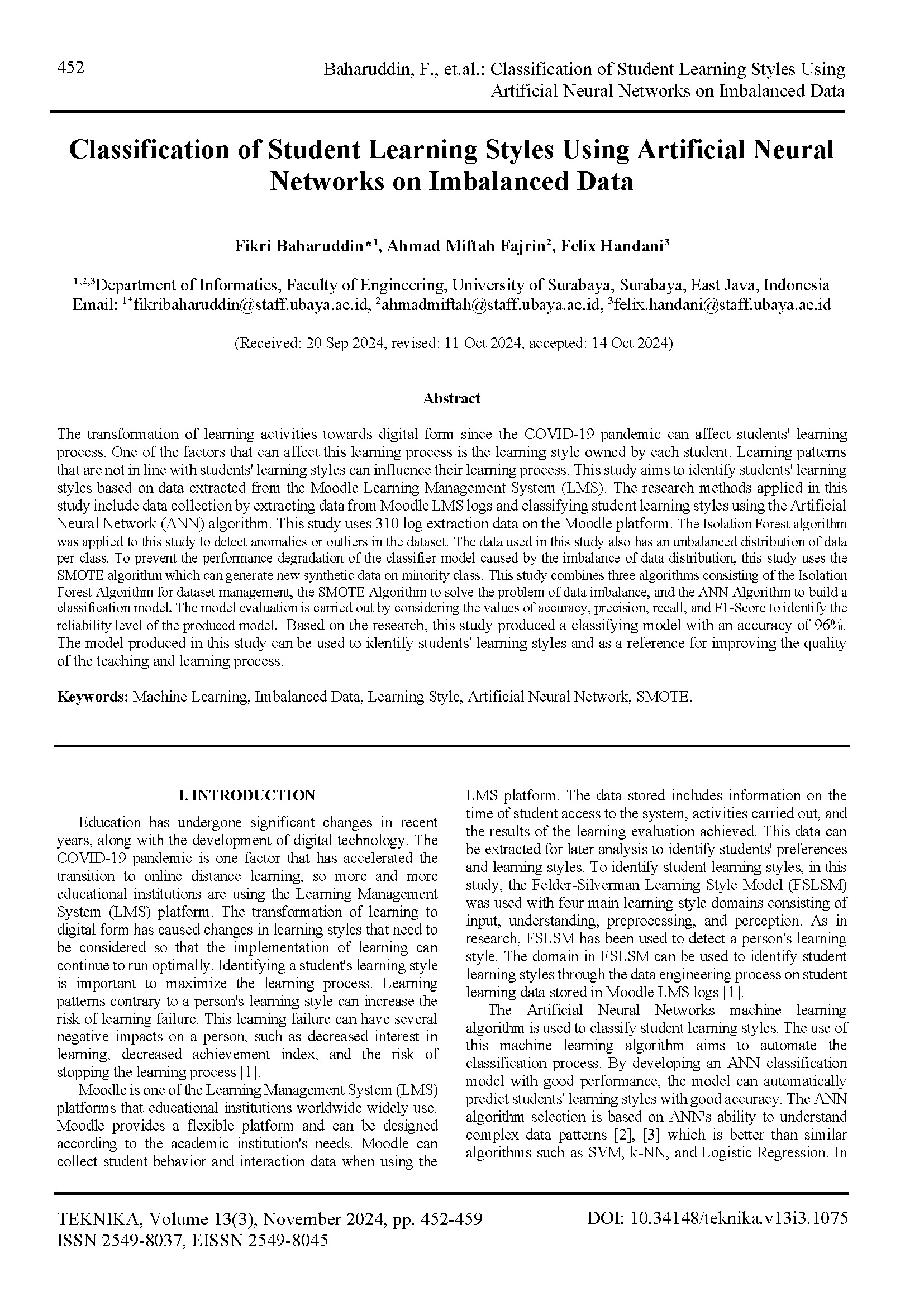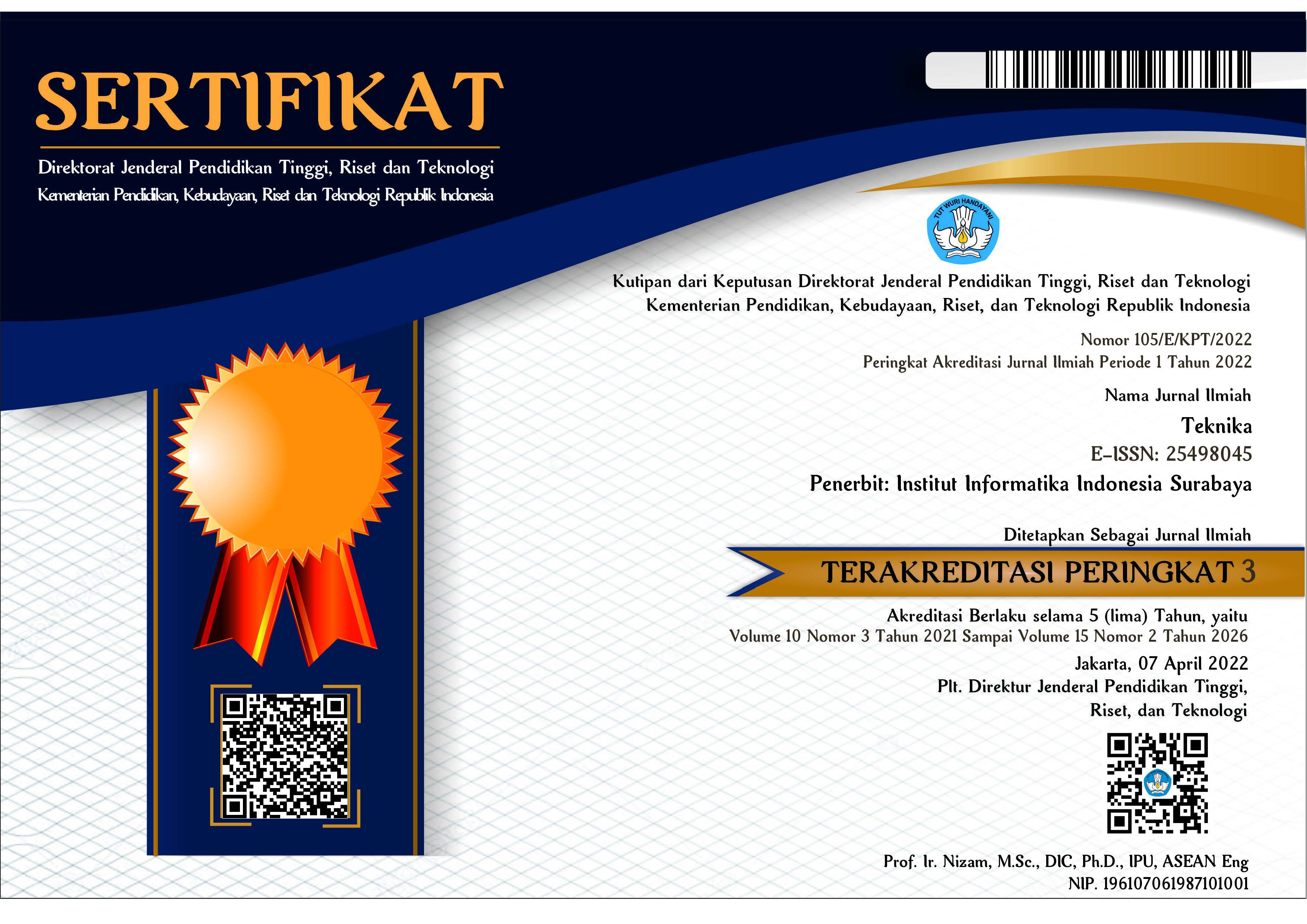Classification of Student Learning Styles Using Artificial Neural Networks on Imbalanced Data
DOI:
https://doi.org/10.34148/teknika.v13i3.1075Keywords:
Machine Learning, Imbalanced Data, Learning Style, Artificial Neural Network, SMOTEAbstract
The transformation of learning activities towards digital form since the COVID-19 pandemic can affect students' learning process. One of the factors that can affect this learning process is the learning style owned by each student. Learning patterns that are not in line with students' learning styles can influence their learning process. This study aims to identify students' learning styles based on data extracted from the Moodle Learning Management System (LMS). The research methods applied in this study include data collection by extracting data from Moodle LMS logs and classifying student learning styles using the Artificial Neural Network (ANN) algorithm. This study uses 310 log extraction data on the Moodle platform. The Isolation Forest algorithm was applied to this study to detect anomalies or outliers in the dataset. The data used in this study also has an unbalanced distribution of data per class. To prevent the performance degradation of the classifier model caused by the imbalance of data distribution, this study uses the SMOTE algorithm which can generate new synthetic data on minority class. This study combines three algorithms consisting of the Isolation Forest Algorithm for dataset management, the SMOTE Algorithm to solve the problem of data imbalance, and the ANN Algorithm to build a classification model. The model evaluation is carried out by considering the values of accuracy, precision, recall, and F1-Score to identify the reliability level of the produced model. Based on the research, this study produced a classifying model with an accuracy of 96%. The model produced in this study can be used to identify students' learning styles and as a reference for improving the quality of the teaching and learning process.
Downloads
References
T. Sheeba and R. Krishnan, “Prediction of student learning style using modified decision tree algorithm in e-learning system,” in Proceedings of the 2018 International Conference on Data Science and Information Technology, 2018, pp. 85–90.
J. Cuauhtemoc et al., “AI‐Based Prediction of Capital Structure: Performance Comparison of ANN SVM and LR Models,” Wiley Online LibraryJC Tellez Gaytan, K Ateeq, A Rafiuddin, HM Alzoubi, TM Ghazal, TA Ahanger, S ChaudharyComputational intelligence and neuroscience, 2022•Wiley Online Library, vol. 2022, 2022, doi: 10.1155/2022/8334927.
K. Alhumaid, M. Habes, and S. A. Salloum, “Examining the Factors Influencing the Mobile Learning Usage during COVID-19 Pandemic: An Integrated SEM-ANN Method,” IEEE Access, vol. 9, pp. 102567–102578, 2021, doi: 10.1109/ACCESS.2021.3097753.
S. Tiodora, S. | Umi, L. Yuhana, * Umi, and P. Address, “Student behaviour analysis to detect learning styles using decision tree, Naïve Bayes, And K-Nearest Neighbor method in moodle learning management system,” iptek.its.ac.idST Sianturi, UL YuhanaIPTEK The Journal for Technology and Science, 2022•iptek.its.ac.id, vol. 33, no. 2, pp. 853–4098, doi: 10.12962/j20882033.v33i2.13665.
K. Dobashi, C. P. Ho, C. P. Fulford, M. F. Grace Lin, and C. Higa, “Learning pattern classification using moodle logs and the visualization of browsing processes by time-series cross-section,” Computers and Education: Artificial Intelligence, vol. 3, Jan. 2022, doi: 10.1016/J.CAEAI.2022.100105.
Y. Ikawati, M. U. H. Al Rasyid, and I. Winarno, “Student Behavior Analysis to Detect Learning Styles in Moodle Learning Management System,” IES 2020 - International Electronics Symposium: The Role of Autonomous and Intelligent Systems for Human Life and Comfort, pp. 501–506, Sep. 2020, doi: 10.1109/IES50839.2020.9231567.
M. Liyanage, … K. G.-… I. J. on, and undefined 2014, “Using learning styles to enhance learning management systems,” journal.icter.orgMPP Liyanage, KSL Gunawardena, M HirakawaThe International Journal on Advances in ICT for Emerging Regions, 2014•journal.icter.org, Accessed: Sep. 18, 2024. [Online]. Available: https://journal.icter.org/index.php/ICTer/article/view/179
A. S. Sprock, “Inclusion of the FuzzyILS method in MOODLE for creating effective courses,” International Journal of Learning, Teaching and Educational Research, vol. 19, no. 10, pp. 32–59, Oct. 2020, doi: 10.26803/IJLTER.19.10.3.
I. Azzi, A. Jeghal, A. Radouane, A. Yahyaouy, and H. Tairi, “A robust classification to predict learning styles in adaptive E-learning systems,” Educ Inf Technol (Dordr), vol. 25, no. 1, pp. 437–448, Jan. 2020, doi: 10.1007/S10639-019-09956-6.
G. G. Murillo, P. Novoa-Hernández, H. Hernández, and R. Serrano Rodríguez, “Technology Acceptance Model and Moodle: A systematic mapping study,” journals.sagepub.comGG Murillo, P Novoa-Hernández, RS RodriguezInformation Development, 2021•journals.sagepub.com, vol. 37, no. 4, pp. 617–632, Nov. 2021, doi: 10.1177/0266666920959367.
M. Zabolotniaia, Z. Cheng, E. Dorozhkin, and A. Lyzhin, “Use of the LMS Moodle for an effective implementation of an innovative policy in higher educational institutions.,” pdfs.semanticscholar.orgM Zabolotniaia, Z Cheng, E Dorozhkin, A LyzhinInternational Journal of Emerging Technologies in Learning, 2020•pdfs.semanticscholar.org, vol. 15, no. 13, pp. 172–189, Jan. 2020, doi: 10.3991/ijet.v15i13.14945.
D. Keržič, A. Aristovnik, N. Tomaževič, and L. Umek, “An assessment of the effectiveness of Moodle e-learning system for undergraduate public administration education,” International Journal of Innovation and Learning, vol. 21, no. 2, p. 165, 2017, doi: 10.1504/IJIL.2017.10002132.
B. Bervell, I. U.-E. J. of Mathematics, S. and, and undefined 2017, “A decade of LMS acceptance and adoption research in Sub-Sahara African higher education: A systematic review of models, methodologies, milestones and main,” ejmste.comB Bervell, IN UmarEurasia Journal of Mathematics, Science and Technology Education, 2017•ejmste.com, vol. 13, no. 11, pp. 7269–7286, 2017, doi: 10.12973/ejmste/79444.
N. Kadoic and D. Oreski, “Analysis of student behavior and success based on logs in Moodle,” 2018 41st International Convention on Information and Communication Technology, Electronics and Microelectronics, MIPRO 2018 - Proceedings, pp. 654–659, Jun. 2018, doi: 10.23919/MIPRO.2018.8400123.
F. Amankwah, F. K. Sarfo, M. O. Aboagye, D. Konin, and R. K. Dzakpasu, “Concerns of university teachers about the adoption of the Moodle learning management system in a Ghanaian University campus,” Taylor & FrancisF Amankwah, FK Sarfo, MO Aboagye, D Konin, RK DzakpasuEducation inquiry, 2024•Taylor & Francis, vol. 15, no. 3, pp. 312–332, 2022, doi: 10.1080/20004508.2022.2109849.
R. Felder, L. S.-E. education, and undefined 1988, “Learning and teaching styles in engineering education,” academia.eduRM Felder, LK SilvermanEngineering education, 1988•academia.edu, Accessed: Sep. 18, 2024. [Online]. Available: https://www.academia.edu/download/31039406/LS-1988.pdf
M. Dominic, B. Anthony Xavier, and S. Francis, “A Framework to Formulate Adaptivity for Adaptive e-Learning System Using User Response Theory,” International Journal of Modern Education and Computer Science, vol. 7, no. 1, pp. 23–30, Jan. 2015, doi: 10.5815/IJMECS.2015.01.04.
T. Sheeba and R. Krishnan, “Prediction of student learning style using modified decision tree algorithm in e-learning system,” in Proceedings of the 2018 International Conference on Data Science and Information Technology, 2018, pp. 85–90.
F. Baharuddin, “Dataset Log Data Moodle for SLSA,” Sep. 2024, Zenodo. doi: 10.5281/zenodo.13819870.
T. Nyitrai and M. Virág, “The effects of handling outliers on the performance of bankruptcy prediction models,” Socioecon Plann Sci, vol. 67, pp. 34–42, Sep. 2019, doi: 10.1016/J.SEPS.2018.08.004.
F. T. Liu, K. M. Ting, and Z.-H. Zhou, “Isolation Forest,” in 2008 Eighth IEEE International Conference on Data Mining, 2008, pp. 413–422. doi: 10.1109/ICDM.2008.17.
W. R. Chen, Y. H. Yun, M. Wen, H. M. Lu, Z. M. Zhang, and Y. Z. Liang, “Representative subset selection and outlier detection: Via isolation forest,” Analytical Methods, vol. 8, no. 39, pp. 7225–7231, Oct. 2016, doi: 10.1039/C6AY01574C.
Z. Cheng, C. Zou, and J. Dong, “Outlier detection using isolation forest and local outlier factor,” in Proceedings of the Conference on Research in Adaptive and Convergent Systems, in RACS ’19. New York, NY, USA: Association for Computing Machinery, 2019, pp. 161–168. doi: 10.1145/3338840.3355641.
R. C. Ripan et al., “An Isolation Forest Learning Based Outlier Detection Approach for Effectively Classifying Cyber Anomalies,” in Hybrid Intelligent Systems, A. Abraham, T. Hanne, O. Castillo, N. Gandhi, T. Nogueira Rios, and T.-P. Hong, Eds., Cham: Springer International Publishing, 2021, pp. 270–279.
S. Bujang, A. Selamat, O. Krejcar, … F. M.-I., and undefined 2022, “Imbalanced classification methods for student grade prediction: a systematic literature review,” ieeexplore.ieee.org, Accessed: Sep. 18, 2024. [Online]. Available: https://ieeexplore.ieee.org/abstract/document/9965398/
A. Yaqin, M. Rahardi, F. A.-I. J. of, and undefined 2022, “Accuracy Enhancement of Prediction Method using SMOTE for Early Prediction Student’s Graduation in XYZ University,” researchgate.net, vol. 13, no. 6, p. 2022, 2022, doi: 10.14569/IJACSA.2022.0130652.
M. Shrinidhi, … T. K. J.-A. in S., and undefined 2023, “Classification of Imbalanced Datasets Using Various Techniques along with Variants of SMOTE Oversampling and ANN,” Trans Tech Publ, Accessed: Sep. 18, 2024. [Online]. Available: https://www.scientific.net/AST.124.504
T. Riston, S. Suherman, … Y. Y.-… S. and I., and undefined 2023, “Oversampling Methods for Handling Imbalance Data in Binary Classification,” Springer, Accessed: Sep. 18, 2024. [Online]. Available: https://link.springer.com/chapter/10.1007/978-3-031-37108-0_1
A. Bokhare, A. Bhagat, R. B.-S. C. Science, and undefined 2023, “Multi-layer perceptron for heart failure detection using SMOTE technique,” Springer, Accessed: Sep. 18, 2024. [Online]. Available: https://link.springer.com/article/10.1007/s42979-022-01596-x
C. Kaope, Y. P.-M. Jurnal, and undefined 2023, “The Effect of Class Imbalance Handling on Datasets Toward Classification Algorithm Performance,” journal.universitasbumigora.ac.id, vol. 22, no. 2, pp. 227–238, 2023, doi: 10.30812/matrik.v22i2.2515.
A. Jalal and M. Mahmood, “Students’ behavior mining in e-learning environment using cognitive processes with information technologies,” Educ Inf Technol (Dordr), vol. 24, no. 5, pp. 2797–2821, Sep. 2019, doi: 10.1007/S10639-019-09892-5.
J. L. Rastrollo-Guerrero, J. A. Gómez-Pulido, and A. Durán-Domínguez, “Analyzing and predicting students’ performance by means of machine learning: A review,” Applied Sciences (Switzerland), vol. 10, no. 3, Feb. 2020, doi: 10.3390/APP10031042.
C. Yu, J. Wu, A. L.-E. sciences, and undefined 2019, “Predicting learning outcomes with MOOC clickstreams,” mdpi.comCH Yu, J Wu, AC LiuEducation sciences, 2019•mdpi.com, vol. 9, no. 2, Jun. 2019, doi: 10.3390/educsci9020104.
K. Nahar, B. I. Shova, T. Ria, H. B. Rashid, and A. H. M. S. Islam, “Mining educational data to predict students performance: A comparative study of data mining techniques,” Educ Inf Technol (Dordr), vol. 26, no. 5, pp. 6051–6067, Sep. 2021, doi: 10.1007/S10639-021-10575-3.























